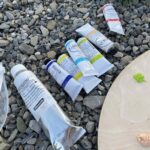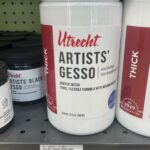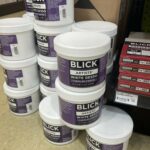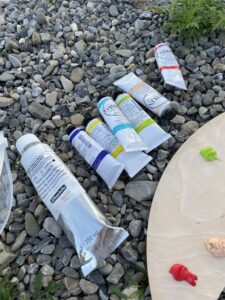Body painting: A comprehensive guide
Are you interested in body painting and wondering how to do it safely, and professionally? This post will teach you how.
What is body painting?
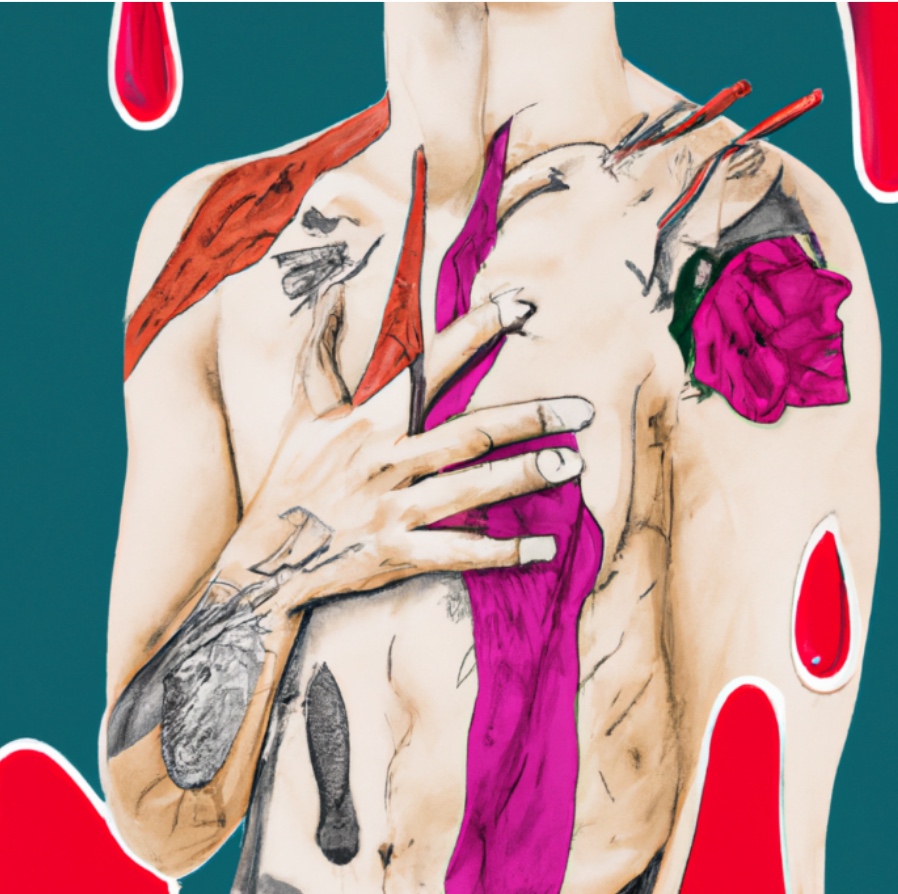
Body painting is a general term that refers to many kinds of decorating and painting on the human body. People have practiced it for centuries in cultures around the world for many different reasons, including self-expression, cultural tradition, or artistic performance.
Step-by Step: How to body paint
This step by step guide will explain how to body paint professionally and beautifully. Remember, you can body paint using many kinds of pigments, colors, and designs. Don’t be afraid to be creative.
What kind of paint do you use for body paint?
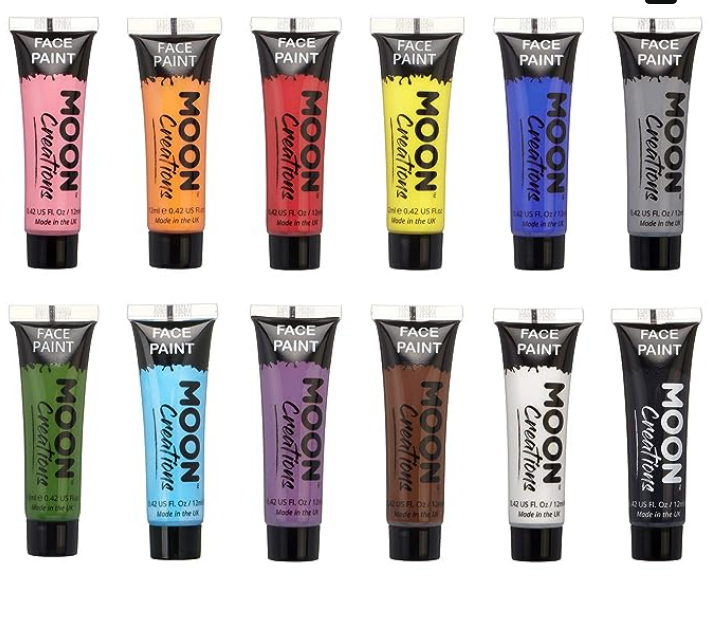
First, it is important that you use non-toxic paints or dyes. That is because you will apply designs directly onto someone’s skin.
Try this basic kit to start: Face & Body Paint Set of 12 by Moon Creations
Airbrushing, Glow in the Dark, and More
Then, it is important to identify your goals as a body painting artist. Do you want your resulting design to be temporary, so the paint is easily removable?
Or, do you want the paint to be more long-lasting, using techniques like airbrushing or specialized paints for the skin? If you are looking for more permanent, professional results, check out the video below to see a kit for airbrushing on a budget, while still getting great results.
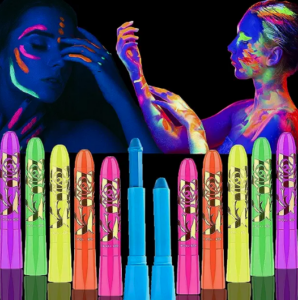
Do you want the paint to glow in the dark? If so, you. can try 12 Pack Glow in The Dark Paint, Glow in The Dark Face Body Paint Glow Sticks. Try scouring Halloween or party stores after the holidays for great sales on these types of body crayons.
Ultimately, there are lots of options in body painting, and you need to be clear about your goals so you can pick the appropriate paint for your artwork.
It’s important to note that body painting should always be done with safe and non-toxic materials. Always follow proper hygiene practices.
Then, there are some guidelines for ethical body paint. First, you should obtain consent from the individuals before you paint them. Additionally, you should respect cultural sensitivities around body painting.
How to body paint
What do you need to do body painting?
Materials You Need
First, gather your supplies. This is what you will need to body paint: water-based paint, brushes, sponges, towel, stamps, setting powder, and finally…glitter!
Read more about each materials below.
- Medium: Choose water-based body paint that is safe for use on the skin. You can find body paints in various colors and finishes, such as matte or metallic.
- Brushes: Get a variety of brushes in different sizes and shapes to achieve different effects.
- Makeup sponges: These are useful for blending and creating smooth transitions.
- Water and towel: Have a bowl of clean water and a towel nearby for rinsing brushes and wiping excess paint.
- Stencils and stamps (optional): If you want to add specific designs or patterns, stencils and stamps can be handy.
- Setting powder (optional): If you want to enhance the longevity of your body paint, you can use setting powder.
- Fine glitter or shimmer (optional): If you want to add some sparkle, have some fine cosmetic-grade glitter or shimmer powder available.
Step-by-step Guide: Body painting
Follow the ten steps below to creating stunning, safe, body painting masterpieces.
1. Prepare the skin
Ensure the skin is clean and free of any oils, lotions, or moisturizers. This helps the body paint adhere better and prevents smudging.
If you have any cuts, rashes, or sensitive areas, avoid applying body paint to those areas.
2. Plan your design
Sketch out your design on paper or have a clear idea of what you want to create on the body. This will help you stay organized and focused during the painting process.
3. Start with a base coat
Use a large brush or sponge to apply a base coat of body paint to the entire area you’re painting. This will provide a uniform background color for your design.
Apply the base coat evenly, making sure to cover all areas of the skin.
4. Add details and layers
Use smaller brushes or sponges to add details and additional layers to your design.
Start with the lighter colors and gradually work towards darker shades.
Use different brushes to create various textures, strokes, and effects as needed.
5. Blend and shade
Use a clean, damp sponge or brush to blend colors together and create smooth transitions.
For shading, use darker shades of paint and lightly apply them to the desired areas. Blend them out gently for a realistic effect.
6. Use stencils and stamps (optional)
If you have stencils or stamps, carefully place them on the painted area and apply paint over them to create specific patterns or designs.
Allow the paint to dry before removing the stencil or stamp.
7. Apply glitter or shimmer (optional)
If you want to add some sparkle, lightly dust or apply fine glitter or shimmer over the painted area. You can use a brush or your fingers for this step.
8. Allow the paint to dry
Give the body paint sufficient time to dry completely before moving or touching the painted area. Follow the instructions on the body paint product for the recommended drying time.
9. Set the body paint (optional)
To increase the longevity of your body paint, you can lightly dust setting powder over the painted area using a large, fluffy brush. This helps to set the paint and reduce smudging.
10. Removal
To remove the body paint, use a gentle cleanser or mild soap and warm water. Avoid scrubbing too hard, as it may irritate the skin. You can also use makeup wipes or a damp cloth to remove excess paint.
It’s important to note that body painting should always be done with safe and non-toxic materials. Always follow proper hygiene practices.
Then, there are some guidelines for ethical body paint. First, you should obtain consent from the individuals before you paint them. Additionally, you should respect cultural sensitivities around body painting.
Remember, practice makes perfect when it comes to body painting. Experiment with different techniques, be patient, and have fun creating your designs!
Check out Pinterest for some inspiration
Explore Carmon de Silva’s board “Body Paint” on Pinterest or Ky Mirabel’s board “Body painting“, followed by 279 people on Pinterest.
Get inspired! Body painting festivals
If you are looking for inspiration for your body painting, there are lots of festivals that celebrate the art form. Here are a few notable events I think you should check out.
World Bodypainting Festival (Austria)
One of the most renowned body painting events, the World Bodypainting Festival takes place annually in Klagenfurt, Austria. It features competitions, workshops, exhibitions, and performances, attracting artists and visitors from all over the world.
North American Body Painting Championship (USA)
Held in Greensboro, North Carolina, this championship brings together artists from North America to compete in different categories. It offers a platform for artists to showcase their talent and creativity.
International Body Painting Contest (Germany)
Organized as part of the International Tattoo Convention in Frankfurt, Germany, this contest showcases talent worldwide. Artists compete in various categories, and the event attracts a diverse audience.
International Body Art Festival (South Korea)
Held in Jeju, South Korea, this festival brings together artists, performers, and enthusiasts. It features live demonstrations, competitions, and cultural performances.
Australian Body Art Festival (Australia)
Located in Eumundi, Queensland, this festival celebrates various forms of art, including body painting, face painting, and wearable art. It features competitions, workshops, and a vibrant parade showcasing incredible artistic creations.
Bodypainting Day
Bodypainting Day is an event that takes place in different cities around the world, including New York City, Amsterdam, and San Francisco. It promotes body positivity, artistic expression, and the acceptance of the human form.
These are just a few examples, and there may be other local or regional festivals and events in different countries. Always check the official websites or social media pages of these festivals. They will give you updated information about their schedules, locations, and participation opportunities.
Where can I study body painting?
Additionally, you can study body painting to become even better at it. Here are a few ways to study this art form.
Art Schools and Universities
Look for art schools or universities that offer programs or courses in fine arts, painting, or illustration. While body painting may not be a dedicated course in all institutions, you can still gain a strong foundation in artistic techniques, color theory, and composition, which can be applied to body painting. Consider pursuing a BA or an MFA.
Workshops and Masterclasses
Many experienced body painting artists offer workshops and masterclasses where they share their techniques, insights, and expertise. These workshops can provide hands-on experience, guidance, and the opportunity to learn from established professionals. Search online for workshops or check with local art organizations or community centers for upcoming events.
Specialized Body Painting Schools
There are specialized schools and academies that focus specifically on body painting. These institutions provide comprehensive training and education in techniques, materials, figure anatomy, and professional practices. Some examples include the International School of Body Art in the United States and the Academy of Freelance Makeup in the United Kingdom.
Online Courses and Tutorials
With the rise of online learning, there are numerous platforms and websites that offer online courses and tutorials on body painting. These courses often provide video lessons, step-by-step demonstrations, and access to instructors who can provide feedback and guidance remotely. Websites like Udemy, Skillshare, and YouTube can be good starting points for finding online resources.
Apprenticeships and Mentorships
If you have the opportunity, consider seeking apprenticeships or mentorships with established body painting artists. This hands-on learning experience allows you to work closely with experienced practitioners, learn their techniques, and gain practical insights into the profession.
Who are some famous body painters?
Several renowned body painters have made significant contributions to the field and gained recognition for their artistic talent. Here are some examples of famous body painters:
Joanne Gair
Joanne Gair is a New Zealand-born body painter known for her incredible skill and creativity. She has worked with numerous high-profile clients, including celebrities, musicians, and major brands. Her work has been featured in Sports Illustrated Swimsuit Edition, Vanity Fair, and Vogue.
Craig Tracy
Craig Tracy is a prominent body painter based in the United States. He is known for his intricate and detailed body art creations, often incorporating elements of nature and illusion. Tracy’s work has been showcased in galleries worldwide, and he has won multiple awards for his artistry.
Veruschka
Veruschka, whose real name is Vera Lehndorff, is a German model and artist who became famous for her collaboration with photographers and her body painting projects in the 1960s and 1970s. Her work challenged traditional notions of beauty and pushed the boundaries of artistic expression.
Emma Hack
Emma Hack is an Australian artist known for her unique body painting techniques. She often blends body painting seamlessly with the background, creating mesmerizing illusions and camouflage effects. Hack’s work has been exhibited internationally, and she has collaborated with various commercial and artistic projects.
Johannes Stötter
Johannes Stötter is an artist from Italy who gained global recognition for his incredible illusions and creations. People know him for his ability to transform human bodies into animals, objects, and natural landscapes. Stötter’s work has garnered millions of views on social media platforms and has won him numerous awards.
These are just a few examples of famous body painters who have made a significant impact on the field. However, there are many other talented and influential body painters around the world, each with their unique styles and contributions to the art form.
How can I get paid to body paint?
Getting paid to body paint involves building your skills, establishing a reputation, and creating opportunities for yourself. Here are some steps you can take to start earning income from your craft:
- Hone Your Skills: Focus on improving your body painting techniques, exploring different styles, and developing a unique artistic voice. Continually practice and experiment to refine your skills and expand your portfolio.
- Build a Portfolio: Create a portfolio showcasing your best work. Include high-quality photographs that highlight the diversity and quality of your designs. Consider collaborating with photographers, models, or other artists to capture professional images of your body painting creations.
- Network and Collaborate: Connect with models, photographers, event organizers, and fellow artists to build a network within the arts community. Attend body painting events, art exhibitions, and workshops to meet like-minded individuals and explore collaborative opportunities.
- Offer Services: Start offering services for events, performances, photoshoots, and private clients. Advertise your services through your website, social media platforms, and local directories. Be clear about the types of body painting you offer, pricing, and any additional services such as face painting or special effects.
- Seek Professional Opportunities: Look for professional opportunities in entertainment, fashion, advertising, or film industries that require body painting. Contact production companies, agencies, and event organizers to offer your services or inquire about potential collaborations.
- Participate in Competitions: Enter competitions to showcase your skills and gain exposure. Winning or placing in competitions can increase your visibility and credibility within the body painting community.
- Collaborate with Businesses and Brands: Approach businesses, brands, or organizations that align with your artistic style and propose collaborations. People can use body painting promotional campaigns, advertisements, or special events, providing opportunities for paid work and exposure.
- Teach Workshops and Classes: Once you have established yourself as a skilled body painter, consider offering workshops or classes to share your knowledge and expertise with others. This can be done in person or online, and it allows you to generate income while sharing your passion.
Remember that building a career takes time and dedication. Continuously seek opportunities to improve your skills, market yourself effectively, and provide excellent service to your clients.
Remember to research and verify the credibility and reputation of the events, artists, or organizations you come across to ensure a safe and enjoyable experience.
